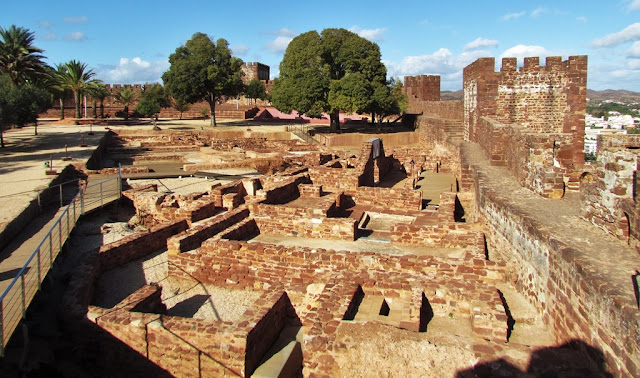SILVES
37.19372 N; 8.43433 W
Silves is a city and municipality in the Portuguese region of Algarve, in southern Portugal. The population of the entire municipality of Silves in 2011 was 37,126, in an area of 680.06 km2. The urbanized area of the city proper has approximately 11,000 inhabitants. Silves is the former capital of the Kingdom of the Algarve (1249–1910), a nominal kingdom within the Kingdom of Portugal (1139-1910), and is of great historical importance.
The town is situated on a hill above the Arade River. Silves Castle is located on the top of the hill. It occupies ca. 12,000 m2. Archaeological excavations have shown that the oldest buildings date back to the 8th century, the stratigraphy is almost 6 m deep and contains Iron Age remains as well.
Geography
The municipality is crossed by the Arade River, which was navigable in historical times and was key to the prosperity of the city of Silves. The waters of the river are used in the reservoirs of Arade and Funcho. The landscape of the municipality is generally hilly. To the south, the municipality borders the Atlantic Ocean.
Silves is built on top of one of the largest underground aquifers in the south of Portugal, The Querença-Silves Aquifer, and has many orange groves, a fruit introduced by the Moors.
Silves is about 15 kilometers north of the nearest stretch of the Algarve coast, 20 kilometers northeast of Portimão, and 62 kilometers northwest of Faro International Airport, by road.
Climate
Silves has a Mediterranean climate (Köppen: Csa) with hot, very dry summers and mild, wet winters. The climate in the municipality of Silves is slightly more continental than the Algarvian coast, leading temperatures to be higher during the day and lower during the night in every season of the year. Temperatures in the winter vary between 17 °C (63 °F) during the day and 5–6 °C (41–43 °F) at night. Temperatures in the summer vary between 30–31 °C (86–88 °F) during the day and 15–17 °C (59–63 °F) at night.
CASTLE OF SILVES
The Castle of Silves is a castle in the civil parish of Silves in the municipality of Silves in the Portuguese Algarve. It's believed that the first fortifications were built upon a possible Lusitanian castro, by the Romans or Visigoths. Between the 8th and 13th centuries, the castle was occupied by the Moors who expanded it, making it one of the best-preserved Moorish fortifications in Portugal.
Around 716 A.D., the Visigothic citadel was conquered by the Umayyad Caliphate who reinforced the existing fortifications with a new series of walls. This new period resulted in a great period of development, under the Moorish occupiers, which include the extensive walls in the west. In 1160, it was sacked by Ferdinand I of León and Castile, but remained only for a short time in the hand of the Christians: it was quickly recaptured by the Moors.[2] King Sancho I of Portugal, supported by the powerful Crusader army, conquered the city after a prolonged siege in 1189.[2] But, a grande army, under orders from Amir al-Mu'minin, in 1191, retook the city.[2] The buildings of the Taifa kingdoms of the 11th century, which include the Palace of Balconies (where Al-Mutamid, lived as the poet Ibn Amarhe) progressed in the 11th century. The walls and towers that today represent the Castle of Silves came from these campaigns and public works by Almoravides and Almohads in the 12th and 13th centuries.[1][2] The castle's internal water catchment and large rain-fed underground cistern were used to provide fresh water for the surrounding dwellings (as late as the 1920s). It would only be in the 13th century, during the reign of Afonso III of Portugal, that forces under the command of D. Paio Peres Correia, would definitively take the fortress.
💓💓💓💓💓
SEARCH IN ALPHABETICAL ORDER
IN THE DISTRICT OF FARO
💓💓💓💓💓
Return to mainland Portugal &
the Azores and Madeira islands















































































































